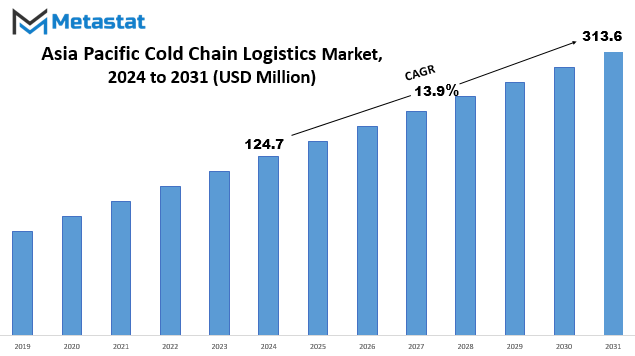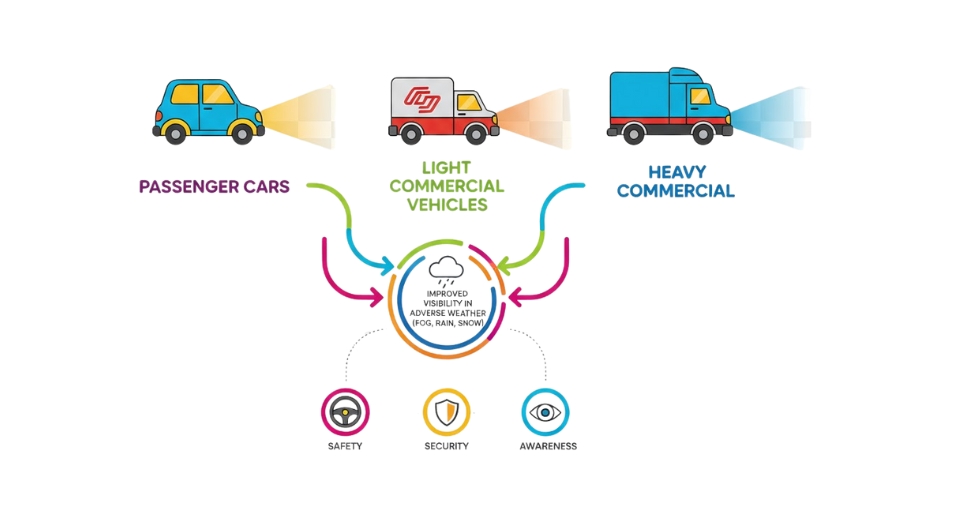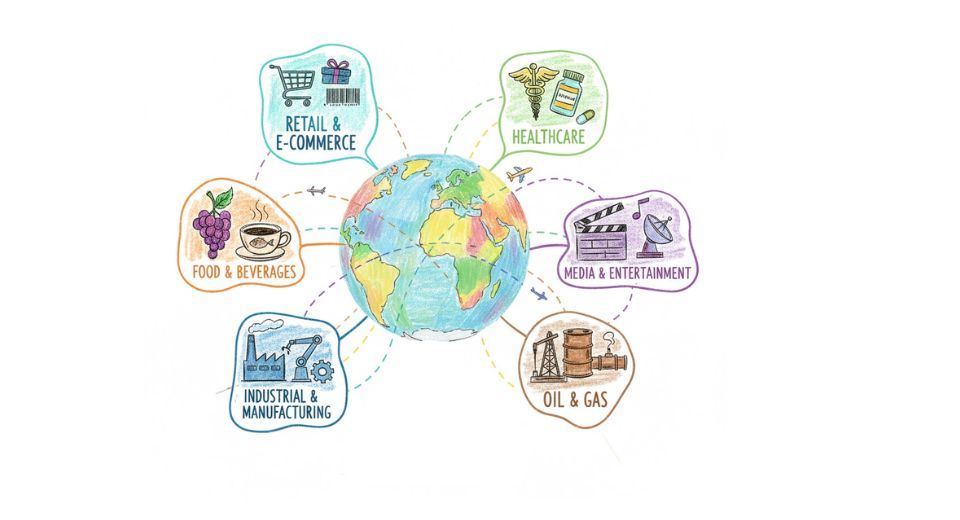MARKET OVERVIEW
The Asia Pacific Cold Chain Logistics Market is a complex network of interconnected services designed to maintain the integrity of temperature-sensitive products throughout their journey. From the icy cold storage units to the meticulously controlled transportation vehicles, every element plays a crucial role in preserving the quality and freshness of items such as pharmaceuticals, food products, and other perishables.
The market’s growth is propelled by a confluence of factors unique to the region. Rapid urbanization and a burgeoning middle class have spurred increased demand for fresh produce and pharmaceuticals, creating a need for robust cold chain infrastructure. As consumers become more discerning, the emphasis on the quality and safety of products during transit has become paramount, further accentuating the role of the cold chain logistics market.
In addition to domestic considerations, the Asia Pacific Cold Chain Logistics Market has positioned itself as a pivotal player in the global trade arena. With many countries engaged in international commerce, the efficient movement of goods across borders has become a key determinant of economic success. The market's ability to navigate the regulatory landscapes of various nations while adhering to stringent quality standards has made it an indispensable ally for businesses engaged in cross-border trade.
The technology landscape within the Asia Pacific Cold Chain Logistics Market is continually evolving, driven by the need for real-time monitoring and data-driven decision-making. Innovations such as IoT-enabled sensors, blockchain technology, and advanced analytics are revolutionizing the way temperature-sensitive goods are handled, providing stakeholders with unprecedented visibility into the supply chain. This enhances efficiency and ensures compliance with the stringent regulatory requirements governing the transportation of perishables.
Challenges, however, abound in this ever-evolving market. Infrastructure gaps, varying regulatory frameworks across countries, and the need for substantial upfront investments pose hurdles to both existing players and potential entrants. Navigating these challenges requires a nuanced understanding of the region’s socio-economic dynamics, making adaptability and strategic foresight essential attributes for success in the Asia Pacific Cold Chain Logistics Market.
Asia Pacific Cold Chain Logistics Market is estimated to reach $313.6 Million by 2031; growing at a CAGR of 13.9% from 2024 to 2031.

GROWTH FACTORS
The Asia Pacific Cold Chain Logistics Market is influenced by a myriad of factors, with drivers and restraints playing pivotal roles in determining its trajectory. One of the significant drivers propelling the market forward is the Rapidly Growing Perishable Goods Market. As consumer preferences shift towards fresh and perishable products, the demand for efficient cold chain logistics experiences a notable surge. This trend is not only reflective of changing consumer habits but also indicative of the evolving dynamics within the supply chain.
In addition to the changing market landscape, Technological Advancements in Cold Chain Infrastructure contribute substantially to the growth of the sector. Innovations in temperature controlled transportation and storage facilities enhance the efficiency and reliability of the cold chain, addressing the evolving demands of a dynamic market. These technological strides not only streamline operations but also play a crucial role in maintaining the integrity of perishable goods throughout the supply chain.
However, amidst the positive momentum, the market faces its fair share of challenges, often classified as restraints. High Operational Costs stand out as a prominent obstacle to the seamless functioning of cold chain logistics in the region. The necessity for specialized equipment, energy intensive facilities, and stringent temperature control measures contribute to the overall operational expenses, creating a financial burden for stakeholders.
Further complicating the landscape are Logistical and Infrastructural Challenges. The vast geographical expanse of the Asia Pacific region poses hurdles in establishing a well-connected and efficient cold chain network. Inconsistent infrastructure development across countries, coupled with diverse regulatory frameworks, adds layers of complexity to the logistical aspect of cold chain operations. These challenges require strategic planning and collaborative efforts to overcome, as they directly impact the effectiveness of the entire cold chain logistics system.
The Asia Pacific Cold Chain Logistics Market is shaped by a delicate interplay of drivers and restraints. The growth in the perishable goods market and technological advancements provide impetus, while high operational costs and logistical challenges present obstacles. Navigating these dynamics requires a nuanced understanding of the market forces at play and a concerted effort from industry stakeholders to address the challenges and capitalize on the opportunities within this dynamic sector.
MARKET SEGMENTATION
By Type
Cold chain logistics in the Asia Pacific region plays a pivotal role in ensuring the seamless transportation and storage of temperature-sensitive goods. This market segment can be broken down into various types, each catering to specific needs and challenges.
The Asia Pacific Cold Chain Logistics Market is divided into four primary segments based on transportation modes: Railways Refrigerated Transport, Airways Refrigerated Transport, Roadways Refrigerated Transport, and Waterways Refrigerated Transport. Understanding the nuances of each segment provides insights into the diverse strategies employed to preserve the quality of perishable products.
Railways Refrigerated Transport constitutes one facet of the market, relying on the extensive rail network prevalent in the region. This mode offers a reliable means of moving goods across vast distances while maintaining a controlled temperature environment. It is particularly effective for connecting inland areas to major distribution centers.
Airways Refrigerated Transport, on the other hand, leverages the speed and efficiency of air travel. This mode is crucial for time-sensitive shipments, ensuring that perishable goods reach their destination swiftly. While more expensive than some alternatives, its rapid transit capabilities make it indispensable for certain industries.
Roadways Refrigerated Transport, a commonly utilized mode, covers the extensive road networks that crisscross the Asia Pacific region. This method offers flexibility and accessibility, making it a preferred choice for transporting perishable goods over shorter to medium distances. It serves as a reliable option for last-mile delivery, connecting production sites to consumers.
Waterways Refrigerated Transport taps into the extensive network of rivers and coastal areas. This mode is vital for transporting goods across borders and connecting regions with navigable water bodies. It offers a cost-effective solution for large-scale transportation while ensuring that products remain at optimal temperatures.
Complementing these transportation modes is the Refrigerated Warehouse segment, serving as a critical node in the cold chain logistics network. These warehouses act as storage hubs, maintaining specific temperature conditions to preserve the integrity of perishable goods before they embark on the next leg of their journey.
The Asia Pacific Cold Chain Logistics Market operates as a well-coordinated system, with each segment playing a unique role in the preservation and transportation of temperature-sensitive products. Whether it’s the efficiency of railways, the speed of air transport, the flexibility of roadways, or the cost-effectiveness of water transport, each mode contributes to a comprehensive and robust cold chain logistics infrastructure in the region.

By Temperature Type
The Asia Pacific Cold Chain Logistics Market is segmented based on Temperature Type, specifically into Frozen and Chilled categories. This division reflects the varying temperature requirements that goods necessitate during transportation and storage within the cold chain logistics system.
The Frozen category encompasses products that demand extremely low temperatures to maintain their quality and integrity. This includes items like frozen foods, ice cream, and certain pharmaceuticals. On the other hand, the Chilled category caters to products that require a moderately low temperature range, such as fresh fruits, vegetables, and certain medicines that are sensitive to higher temperatures but do not need to be frozen.
This market segmentation based on Temperature Type is crucial in addressing the diverse needs of different products within the cold chain logistics framework. It allows for a more precise and effective management of temperature-sensitive goods, ensuring their preservation and quality throughout the entire supply chain process.
In the Asia Pacific region, where diverse climates and geographic challenges exist, this segmentation becomes even more vital. The varying temperature requirements of products must be accommodated seamlessly to prevent spoilage or degradation. Frozen and Chilled categories enable logistics providers to tailor their services to the specific needs of different products, thereby enhancing the overall efficiency and reliability of the cold chain logistics system.
The segmentation of the Asia Pacific Cold Chain Logistics Market based on Temperature Type, namely Frozen and Chilled, is a practical and necessary approach to meet the diverse demands of temperature-sensitive goods. This segmentation enhances the precision and effectiveness of the cold chain logistics system, ensuring the safe and reliable transportation and storage of various products across the region.
By Technology
The Asia Pacific Cold Chain Logistics Market is segmented based on technology, which plays a crucial role in maintaining the integrity of temperature-sensitive products during transportation. This division encompasses Dry Ice, Gel Packs, Eutectic Plates, Liquid Nitrogen, and Quilts.
Dry Ice stands out as a popular choice in cold chain logistics, known for its ability to maintain extremely low temperatures. It’s commonly used for shipping pharmaceuticals, frozen foods, and other perishable goods that require stringent temperature control.
Gel Packs, another technology in the market, offer a more flexible and reusable solution. These packs contain a gel that can be frozen and then placed alongside the cargo to regulate the temperature. Gel Packs are often favored for their versatility in catering to various shipment sizes.
Eutectic Plates are a reliable option, functioning as temperature-stabilizing agents. These plates, when frozen, release a consistent temperature over an extended period, ensuring a steady environment for the transported items.
Liquid Nitrogen, a well-known cryogenic agent, finds its application in cold chain logistics. Its extremely low temperature helps in preserving products that demand ultra-cold storage, such as biological samples and certain pharmaceuticals.
Quilts, on the other hand, provide an insulating layer that helps in maintaining the desired temperature within the shipping container. This technology is particularly useful for protecting goods against external temperature fluctuations.
The diverse range of technologies available in the Asia Pacific Cold Chain Logistics Market reflects the industry’s commitment to ensuring the safe and reliable transportation of temperature-sensitive products. Each technology brings its own set of advantages, allowing businesses to choose the most suitable option based on the specific requirements of their cargo. As the market continues to evolve, the importance of these technologies in preserving product quality and integrity during transit remains paramount.
By Application
The Asia Pacific Cold Chain Logistics Market exhibits a diverse landscape, with various applications steering its growth. This market, which plays a pivotal role in preserving and transporting temperature-sensitive goods, is segmented into several key applications.
Pharmaceuticals stand out as a significant component within the Asia Pacific Cold Chain Logistics Market. The need for maintaining precise temperature control during the transportation and storage of pharmaceutical products is paramount. This stringent requirement arises from the delicate nature of pharmaceuticals, where even slight deviations in temperature can compromise their efficacy. The cold chain logistics system ensures that these products reach their destinations in optimal condition, safeguarding their therapeutic value.
Another crucial segment within this market involves the handling of Dairy and Frozen Desserts. The cold chain logistics network is indispensable for maintaining the freshness and quality of these perishable items. The preservation of optimal temperatures from production to distribution is crucial to prevent spoilage and maintain the taste and texture of dairy products and frozen desserts.
Fruits and Vegetables constitute yet another integral facet of the Asia Pacific Cold Chain Logistics Market. The challenge lies in ensuring that these perishable goods reach consumers with minimal loss of freshness and nutritional value. The cold chain logistics system plays a vital role in extending the shelf life of fruits and vegetables, facilitating their distribution across diverse regions.
Bakery and Confectionery products also find their niche within this market. The precise temperature control provided by the cold chain logistics system is essential to preserve the taste, texture, and quality of baked goods and confectionery items. From the bakery to the end consumer, this network ensures that these products maintain their appeal and meet consumer expectations.
The Cold Chain Logistics Market in the Asia Pacific region also encompasses Processed Food. The transportation and storage of processed food require meticulous temperature management to prevent spoilage and maintain product safety. The cold chain logistics system ensures that processed food items maintain their quality and meet regulatory standards throughout the supply chain.
The market includes an Others category, which encapsulates various products and goods that necessitate controlled temperature logistics. This segment reflects the adaptability and versatility of the cold chain logistics system, catering to a diverse array of products beyond the specified categories.
The Asia Pacific Cold Chain Logistics Market, segmented by applications such as Pharmaceuticals, Dairy and Frozen Desserts, Fruits and Vegetables, Bakery and Confectionery, Processed Food, and Others, plays a pivotal role in preserving the quality and safety of temperature-sensitive goods across diverse industries. As these applications underscore, the cold chain logistics system is a linchpin in ensuring the seamless and efficient distribution of perishable products in the Asia Pacific region.
REGIONAL ANALYSIS
The Asia-Pacific Cold Chain Logistics Market can be analyzed by breaking it down into its key components, comprising India, China, Japan, South Korea, and the Rest of Asia-Pacific. Each of these segments plays a crucial role in shaping the overall landscape of the cold chain logistics industry in the region.
India, with its vast and diverse geographical expanse, presents unique challenges and opportunities for cold chain logistics. The demand for temperature-controlled transportation and storage facilities is on the rise, driven by a growing population and expanding food and pharmaceutical industries. As the Indian economy continues to develop, the cold chain infrastructure is evolving to meet the increasing demand for the seamless transportation of perishable goods.
China, being a major player in the global market, has a well-established cold chain logistics network. The country's extensive geographical reach and diverse climate zones necessitate a robust infrastructure to ensure the integrity of temperature-sensitive products during transportation and storage. With a rapidly growing middle class and an increasing focus on food safety, the cold chain logistics sector in China is witnessing significant growth and innovation.
Japan, known for its advanced technological landscape, boasts a sophisticated cold chain logistics system. The country's efficient transportation networks and cutting-edge technology contribute to the smooth flow of perishable goods. As consumer preferences shift towards fresh and high-quality products, the Japanese cold chain logistics market is adapting to meet these evolving demands.
South Korea, with its developed economy and strategic location, plays a pivotal role in the Asia Pacific cold chain logistics ecosystem. The country's emphasis on technological advancements and adherence to stringent quality standards enhances the efficiency and reliability of its cold chain infrastructure. South Korea's participation in the global supply chain reinforces its position as a key player in the regional cold chain logistics market.
The Rest of Asia-Pacific encompasses a diverse range of countries, each with its own unique challenges and opportunities in the cold chain logistics sector. As these nations undergo economic development and urbanization, the demand for temperature-controlled logistics solutions is on the rise. The evolving regulatory landscape and increasing awareness of the importance of cold chain logistics further contribute to the dynamic nature of this segment.
COMPETITIVE PLAYERS
The Asia Pacific Cold Chain Logistics Market is a dynamic industry with several key players shaping its landscape. Among the prominent companies in this sector are United Parcel Service of America, Inc., OOCL Logistics Limited, JWD Infologistics Public Company Ltd, Nichirei Logistics Group Inc., Deutsche Post DHL Group, X2 Logistics Networks, AIT Worldwide Logistics, Inc., CWT PTE LIMITED (CWT International Ltd), SF Express, and Rokin Logistics Supply Chain Co., Ltd.
United Parcel Service of America, Inc., stands out as a significant contributor to the Cold Chain Logistics Market. With a global presence, the company plays a pivotal role in the transportation and logistics of temperature-sensitive goods, ensuring their integrity throughout the supply chain.
OOCL Logistics Limited is another key player, leveraging its expertise to provide comprehensive logistics solutions. The company's focus on efficient and reliable cold chain services has positioned it as a formidable force in the market.
JWD Infologistics Public Company Ltd brings its unique capabilities to the table, contributing to the competitiveness of the Cold Chain Logistics Market. Specializing in logistics and supply chain management, JWD Infologistics plays a crucial role in maintaining the integrity of temperature sensitive products.
Nichirei Logistics Group Inc. is recognized for its commitment to delivering top-notch cold chain solutions. As a leading player, the company ensures the smooth and secure transportation of perishable goods, meeting the stringent requirements of the industry.
Deutsche Post DHL Group, a global logistics giant, extends its influence to the Asia Pacific Cold Chain Logistics Market. With a robust network and advanced technology, the company provides end-to end solutions for cold chain management, catering to the diverse needs of clients.
X2 Logistics Networks adds a collaborative dimension to the market, fostering connections and partnerships within the industry. This approach enhances the overall efficiency and effectiveness of cold chain logistics operations.
AIT Worldwide Logistics, Inc. is a key player known for its innovative solutions in the cold chain space. The company's commitment to technological advancements and customer satisfaction contributes significantly to its competitive position.
CWT PTE LIMITED (CWT International Ltd) brings its expertise to the Asia Pacific Cold Chain Logistics Market, offering a range of services that contribute to the seamless transportation and storage of temperature-sensitive products.
SF Express, a leading logistics and courier services provider, plays a crucial role in the Cold Chain Logistics Market. The company's extensive network and commitment to excellence make it a reliable partner in the transportation of perishable goods.
Rokin Logistics Supply Chain Co., Ltd stands out with its focus on building a robust and reliable supply chain infrastructure. The company's contribution to the cold chain logistics sector is notable, ensuring the safe and timely delivery of temperature-sensitive goods.
The Asia Pacific Cold Chain Logistics Market is marked by the presence of these key players, each contributing its unique strengths to create a competitive and thriving industry. Their commitment to excellence, innovative solutions, and extensive networks collectively shape the dynamics of the cold chain logistics sector in the region.
Asia Pacific Cold Chain Logistics Market Key Segments:
By Type
- Railways Refrigerated Transport
- Airways Refrigerated Transport
- Roadways Refrigerated Transport
- Waterways Refrigerated Transport
- Refrigerated Warehouse
By Temperature Type
- Frozen
- Chilled
By Technology
- Dry Ice
- Gel Packs
- Eutectic Plates
- Liquid Nitrogen
- Quilts
By Application
- Pharmaceuticals
- Dairy and Frozen Desserts
- Fruits and Vegetables
- Bakery and Confectionery
- Process Food
- Others
Key Asia Pacific Cold Chain Logistics Market Industry Players
- United Parcel Service of America, Inc.
- OOCL Logistics Limited
- JWD Infologistics Public Company Ltd
- Nichirei Logistics Group Inc.
- Deutsche Post DHL Group
- X2 Logistics Networks
- AIT Worldwide Logistics, Inc.
- CWT PTE LIMITED (CWT International Ltd)
- SF Express
- Rokin Logistics Supply Chain Co., Ltd
WHAT REPORT PROVIDES
- Full in-depth analysis of the parent Industry
- Important changes in market and its dynamics
- Segmentation details of the market
- Former, on-going, and projected market analysis in terms of volume and value
- Assessment of niche industry developments
- Market share analysis
- Key strategies of major players
- Emerging segments and regional growth potential








 US: +1 3023308252
US: +1 3023308252






